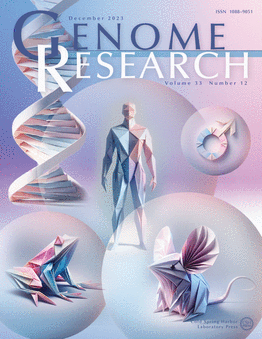结合DNA和蛋白质比对改进LiftOn基因组注释
IF 6.2
2区 生物学
Q1 BIOCHEMISTRY & MOLECULAR BIOLOGY
引用次数: 0
摘要
随着组装基因组的数量和种类不断增加,注释基因组的数量正在落后,特别是对于真核生物。基于dna的制图工具有助于解决这一挑战,但它们只能在密切相关的物种之间传递注释。在这里,我们介绍LiftOn,一个基于同源性的软件工具,集成了DNA和蛋白质比对,以提高基因组尺度注释的准确性,并允许在相对遥远的物种之间进行定位。LiftOn的以蛋白质为中心的算法考虑了这两种类型的比对,选择了最佳的开放阅读框,解决了重叠的基因位点,并在它们存在的地方找到了额外的基因拷贝。LiftOn可以可靠地在代表同一物种成员的基因组之间传递注释,正如我们在人类、小鼠、蜜蜂、水稻和拟南芥上所证明的那样。它可以进一步有效地在物种对之间进行标注,最远可以是小鼠和大鼠,也可以是果蝇和D. erecta。本文章由计算机程序翻译,如有差异,请以英文原文为准。
Combining DNA and protein alignments to improve genome annotation with LiftOn
As the number and variety of assembled genomes continues to grow, the number of annotated genomes is falling behind, particularly for eukaryotes. DNA-based mapping tools help to address this challenge, but they are only able to transfer annotation between closely-related species. Here we introduce LiftOn, a homology-based software tool that integrates DNA and protein alignments to enhance the accuracy of genome-scale annotation and to allow mapping between relatively distant species. LiftOn's protein-centric algorithm considers both types of alignments, chooses optimal open reading frames, resolves overlapping gene loci, and finds additional gene copies where they exist. LiftOn can reliably transfer annotation between genomes representing members of the same species, as we demonstrate on human, mouse, honeybee, rice, and Arabidopsis thaliana. It can further map annotation effectively across species pairs as far apart as mouse and rat or Drosophila melanogaster and D. erecta.
求助全文
通过发布文献求助,成功后即可免费获取论文全文。
去求助
来源期刊

Genome research
生物-生化与分子生物学
CiteScore
12.40
自引率
1.40%
发文量
140
审稿时长
6 months
期刊介绍:
Launched in 1995, Genome Research is an international, continuously published, peer-reviewed journal that focuses on research that provides novel insights into the genome biology of all organisms, including advances in genomic medicine.
Among the topics considered by the journal are genome structure and function, comparative genomics, molecular evolution, genome-scale quantitative and population genetics, proteomics, epigenomics, and systems biology. The journal also features exciting gene discoveries and reports of cutting-edge computational biology and high-throughput methodologies.
New data in these areas are published as research papers, or methods and resource reports that provide novel information on technologies or tools that will be of interest to a broad readership. Complete data sets are presented electronically on the journal''s web site where appropriate. The journal also provides Reviews, Perspectives, and Insight/Outlook articles, which present commentary on the latest advances published both here and elsewhere, placing such progress in its broader biological context.
 求助内容:
求助内容: 应助结果提醒方式:
应助结果提醒方式:


